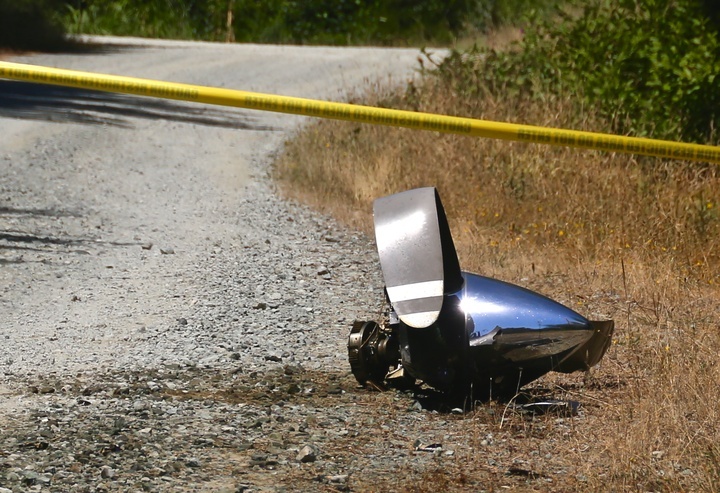
Debris from the crash | AG
Today the National Transportation Safety Board released its preliminary report detailing the events leading up to the July 29 crash of a Cal-Ore Life Flight medical transport plane on Green Diamond Resource Company timber land northeast of McKinleyville. The report chronicles the final radio communications between the plane’s pilot and air traffic control in Seattle.
According to the NTSB, at 12:58 a.m. pilot Larry Mills announced his intent to return to its point of origin in Crescent City — the flight was scheduled to transport a patient to Oakland — “due to the smell of smoke in the cockpit.” Seconds later Mills noted “that it looked like he was going to lose some power shortly, and said he would keep [air traffic control] posted as long as he could.” His final transmission would be less than a minute later.
The plane is estimated to have crashed at 1:05 a.m. All four people on board were killed. Read the National Transportation Safety Board’s release below:
On July 29, 2016, about 0105 Pacific daylight time, a twin-engine, turbine-powered, Piper PA-31T Cheyenne II airplane, N661TC, reported smoke in the cockpit and subsequently sustained an in-flight breakup and collision with tree-covered terrain near Arcata/Eureka Airport, McKinleyville, California. The accident airplane was being operated by Cal-Ore Life Flight as an instrument flight rules (IFR) air transport medical flight under the provisions of Title 14, CFR Part 135. The airline transport pilot, two medical personnel, and one patient were fatally injured; the airplane sustained substantial damage. Dark night, instrument meteorological conditions prevailed. The flight departed Crescent City, California, at 0045, destined for Oakland International Airport, Oakland, California
A preliminary review of archived radar and voice communication data from the Federal Aviation Administration (FAA) revealed that:
- At 0058:12, as the airplane reached an altitude of about 15,000 feet msl, the accident pilot contacted Seattle air route traffic control center (ARTCC) and stated that he was going to turn back to Crescent City due to a smell of smoke in the cockpit.
- At 0058:26, the ARTCC specialist on duty cleared the accident airplane direct to the Crescent City Airport, issued him a descent clearance to 9,000 feet, and told him to let her know if he needed anything else.
- At 0058:41, the accident pilot said “okay,” and he stated that it looked like he was going to lose some power shortly, and said he would keep her posted as long as he could.
- At 0058:52, the ARTCC specialist issued the Crescent City altimeter of 29.98, and then requested the total number of occupants on board, and how much fuel was remaining.
- At 0059:07, the accident pilot stated that he had smoke in the cockpit, declared an emergency, said he was depressurizing and was heading back to Crescent City.
- At 0059:21, the accident pilot asked the ARTCC specialist to call the fire department to have them standing by upon arrival.
- At 0059:25, the ARTCC specialist then acknowledged that crash rescue would be standing by at the Crescent City Airport, and she again asked how many people were on board.
- At 0059:27, the accident pilot stated that he had three on board. There were no further communications received from the accident airplane despite multiple attempts by the ARTCC specialist on duty.
During a telephone conversation with an National Transportation Safety Board (NTSB) investigator, a witness located near Cookson Camp, Arcata, California, reported that in the early morning hours of July 29, she heard an airplane circling overhead before it eventually flew westward, which was followed by about 15 seconds of silence. While looking out the window of her tent, she saw a large dome shaped flash to the west, followed by another flash and a loud rumble.
The NTSB IIC, along with another NTSB investigator, two Federal Aviation Administration safety inspectors from the Oakland Flight Standards District Office (FSDO), two representatives from the Humboldt County Sheriff’s Office, representatives from Cal-Ore Life Flight, and an Piper Aircraft air safety investigator reached the accident site on the afternoon of July 30. The accident site was located in an area of brush and heavily forested terrain. Large portions of the burned and fragmented airplane were scattered along a debris path oriented along a magnetic heading of 354 degrees, which measured about 2,400 feet in length. The fuselage, inboard and outboard sections of the wings, vertical tail, and portions of one horizontal stabilizer, were located in separate locations and exhibited minimal impact damage. Both inboard sections of the wings exhibited post-crash fire damage.
The fuselage and empennage came to rest on its left side and facing the direction of travel. The instrument panel and cockpit exhibited extensive impact damage. The cabin area of the fuselage was largely intact. Evidence of thermal damage was present in the forward section of the fuselage. A section of the forward fuselage, wiring, and associated components were removed and sent to the NTSB Materials Laboratory in Washington, D.C., for further examination.
Both engines separated from their respective engine firewalls and sustained impact damage, however; neither engine exhibited any sign of thermal damage.Control continuity could not be established due to numerous fractures in the system, missing cabling and flight control surfaces; however, all the fractures that were identified exhibited features consistent with tension overload.
The closest weather reporting facility is Arcata/Eureka Airport (KACV), McKinleyville, located approximately 6 miles southwest of the accident site. At 0107, an aviation routine weather report (METAR) at KACV, reported wind 180 degrees at 4 knots; visibility 1/2 statute miles, mist; runway 32 visual range 4,500 feet variable to greater than 6,000 feet, overcast clouds 200 feet; temperature 55 degrees F; dew point 54 degrees F; altimeter 29.85 inHg.
PREVIOUSLY:
CLICK TO MANAGE